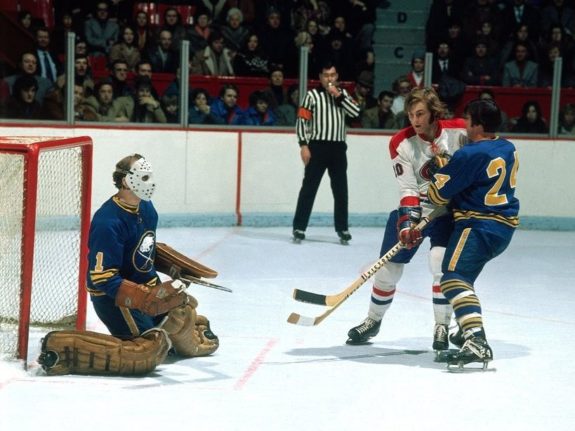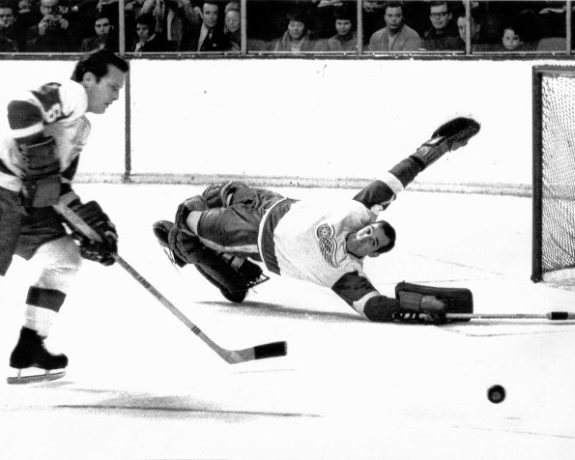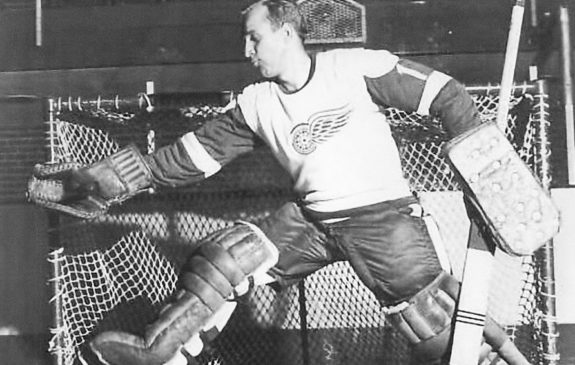There was no player more valuable to the Buffalo Sabres in their first two or three years of the franchise than the acrobatic Roger Crozier. Oftentimes heralded as “The Artful Dodger” in between the pipes for the Sabres, the diminutive 5-foot-8, 160-pound goaltender truly lived up to the moniker. If you watch old footage of Crozier’s career, there were times that he used his goal crease in the way a gymnast might use a balance beam. He would leap through the air to make saves, swing with one arm hung from the crossbar so that he could quickly change direction, or even hook onto one of his goalposts to pull himself across to make a save.
It was not just that Crozier’s saves were spectacular to watch, though they certainly were. No, it was the multitude of saves that he made and his ability to keep scores respectable for the fledgling Sabres when otherwise they would have certainly been blown out. Crozier was the savior of those early Sabres teams, and it was never more apparent than in their first year in the league, 1970-71.

We take a look back at Crozier’s heroics during that first season. While he may have had better years in the NHL during his 14-year career, no season’s performance was more imperative than the one Crozier put forth during that first year in Buffalo. This is what makes his 1970-71 NHL season one for the ages.
Crozier’s Previous Success in the NHL
Crozier was a well-established netminder in the league well before the Buffalo Sabres were even a gleam in Punch Imlach’s eye. Originally the property of the Chicago Blackhawks from playing his junior career for the team-sponsored St. Catharines Teepees, Crozier was traded to the Detroit Red Wings in 1963. From the 1963-64 NHL season until 1969-70, he handled the more sizable chunk of action for the “Winged Wheels”.
Don’t Miss Our One for the Ages Collection, including:
- Alex Delvecchio
- Doug Harvey
- Billy Smith
- Ray Whitney
Crozier was never more important to the success of the Red Wings than during the middlemost years of the 1960s. After just 15 regular season games during the 1963-64 season, Crozier suited up for all 70 regular season games of 1964-65. He compiled a remarkable 40 wins for Detroit to go along with seven ties, and a rather minuscule 22 losses. That included six shutouts and a very solid .913 save percentage in net. Deservedly so, Crozier received the Calder Trophy as the NHL’s most outstanding rookie that season.

Keep in mind too that with the emergence of such a remarkable young goaltender, it would not have been unheard of for the Wings to regain some of their glory days from the 1950s. Though most of them were well into their 30s at this point in time, that same 1964-65 season Detroit still had legendary players like Alex Delvecchio, Ted Lindsay, Marcel Pronovost, Bill Gadsby, and of course, “Mr. Hockey” Gordie Howe leading their charge.
Therefore, it was not at all surprising that in his next full season, surrounded by such a profound supporting cast, Crozer vaulted the Red Wings into the Stanley Cup Final. It would be the first of two championship series that he would play in during his career. Despite his heroics in net, the Red Wings lost in six games to the Montreal Canadiens. Posting a shutout in those playoffs and coming away with a .914 SV% and a 2.34 goals against average, Crozier became the first player in NHL history to be on a losing team and be awarded the Conn Smythe Trophy as the most valuable player in the playoffs.
“The Artful Dodger” Arrives in Buffalo
After the run to the Final, Crozier’s amount of action with Detroit began to diminish. This was namely due to ongoing bouts with pancreatitis, and even depression. The pancreatitis was something that would plague Crozier throughout the duration of his career, and even briefly caused him to retire at the beginning of the 1967-68 season. After his 70-game season, followed by a 64-game one the year he won the Conn Smythe, his games played with the Red Wings then dropped to seasons of 58, 34, 38 and 34.

A change of scenery was needed. Sometimes in instances of illness and depression, the best thing that can happen for an individual is to get a fresh start. That fresh start happened when Crozier was acquired on June 10, 1970 by the Buffalo Sabres and the colorful Punch Imlach, the team’s first general manager and head coach. Imlach knew that in order to be competitive, he had to quickly obtain a goalie who was capable of stonewalling powerhouse offenses like Montreal’s and that of the Chicago Blackhawks. Crozier was his man. In return the Red Wings received Tom Webster who would have one 30-goal season with the team, before going on to have a successful career in the WHA.
Crozier would handle the bulk of the Sabres goaltending duties that first season, but had assistance from both Dave Dryden and a maskless Joe Daley. None of the three goalies posted a winning record that year, although Dryden went 3-3-0 in 10 games. Daley would add up the most wins of the Sabres’ netminders with 12 victories in 38 games. But there is no question about it – the most important of the three was certainly Crozier.
Understanding the Value of Crozier’s 1970-71 Season
Here is the main crux when discussing this particular season in “The Artful Dodger’s” career. Not only were the Sabres extremely fortunate in winning the lottery by a spin of a quasi-roulette wheel, and thus obtaining the franchise’s marquee player in Gilbert Perreault, but Imlach was wise enough to surround his superstar with numerous “golden oldies” up front. During the 1970-71 season, the Sabres forwards featured numerous Stanley Cup champions, and in once instance an eventual Hockey Hall of Famer. Veterans Floyd Smith, Phil Goyette, Don Marshall, Dick Duff, and Eddie “The Entertainer” Shack all provided aged support to Perreault and the team as a whole.
But what you have to understand is that while the proven forwards were rather plentiful for Buffalo, the team’s defense corps that first year left quite a bit to be desired. With the exception of longtime toughie Reggie Fleming who won a Stanley Cup with the Blackhawks in 1961, the remainder of the blueliners (at least at first) were primarily castoffs and journeymen. Doug Barrie, Jim Watson (not to be confused with the Philadelphia Flyers Jimmy Watson), Al Hamilton, Tracy Pratt, Mike McMahon, Hap Myers. These were not household names and often presented Buffalo’s back end as rather beleaguered.
Perhaps recognizing his defensive woes, Imlach would add seven-time Stanley Cup champion Jean-Guy Talbot in November as part of a trade with the St. Louis Blues. Talbot was 38 years old at the time, but finished out his final NHL season with Buffalo. Even with experienced defenders in Talbot and Fleming, the Sabres still gave up the fifth most amount of goals in the league that year. The reason why this total was not worse is solely attributable to Crozier. At times, the nimble goaltender was the definition of brilliance in net.
Crozier’s Finer Performances of the First Year
We take a look now at some of Crozier’s more memorable games during the 1970-71 NHL season:
Oct. 10, 1970: The Buffalo Sabres began their history with a 2-1 win on the road against the Pittsburgh Penguins. While it was rookie star Gilbert Perreault who tucked away the game-winner on Les Binkley, it was Crozier who kept the game so close. While the Sabres only put forth 20 shots, Crozier turned aside 35 of the 36 shots that he faced from Pittsburgh.
Oct. 14, 1970: Even though the Sabres would lose 3-0 at Madison Square Garden against the New York Rangers, Crozier made 44 saves while facing 47 shots. He had to bail his team out, as Buffalo only was able to muster 15 total shots on Ed Giacomin all game long. Crozier meanwhile faced no less than 15 shots in each period.
Oct. 15, 1970: This would be the Sabres’ first home game in the team’s history and would be played in the venerable old Memorial Auditorium against the Canadiens. After Sabres captain Floyd Smith and Montreal’s captain the great Jean Beliveau took the ceremonial face-off, it became a shooting gallery by the “Flying Frenchmen” against Buffalo. Even though the Sabres lost again by a score 3-0, Crozier faced an astounding 53 shots and turned aside 50 of them. He faced 22 in the second period alone. This performance of Crozier’s typified his immeasurable value to the Sabres.
Oct. 17, 1970: The Sabres fourth game saw Crozier make his fourth straight appearance in net. While it came out as another loss, this time 4-1 against the Blues, the more important thing to note is how much work the netminder had seen through just four games. The Blues peppered Crozier with 44 shots, and he stopped 40 of them. This meant that through only four games he had faced 180 shots. That in and of itself is something to marvel at.
Nov. 18, 1970: In what would be Punch Imlach’s first game coached against his former team the Toronto Maple Leafs, the Sabres did not let their man behind the bench down. Buffalo would crush the Maple Leafs 7-2. Still, that victory was not as easy as it sounds. Every Sabre did his part, including Crozier. Even though the score was lopsided, the Sabres goalie still had to make 44 saves on 46 shots.
Dec. 6, 1970: Crozier records the first shutout in Sabres’ history with a 1-0 win over the Minnesota North Stars. He stopped all 24 shots that he faced during the game at The Aud, while right wing Ron Anderson scored the only goal Buffalo would need for the victory.
Jan. 29, 1971: Perreault would scored a hat-trick, including his third goal as an empty-netter, as Buffalo defeated the California Golden Seals 4-2. The trip out west was good for Crozier as he turned aside 31 of the 33 shots he faced to get Buffalo the victory behind Perreault’s brilliant play up front.
Jan. 31, 1971: Two nights later Crozier remained strong in Vancouver as Buffalo took a 6-1 victory over their fellow expansion team. Perreault would score two more goals, while his goaltender steered away 32 of the 33 shots that came at the Sabres. Despite any illnesses or fatigue, Crozier continued to be most strong in net for Buffalo.
Feb. 4, 1971: Still on the Pacific Coast, Crozier and the Sabres faced the Los Angeles Kings. Having been acquired from the Kings earlier in the season, Shack scored a hat-trick against his old team to give Buffalo a decisive 5-2 win. Meanwhile, Crozier stopped 37 of 39 in net.
Feb. 20, 1971: While Gordie Howe would beat him in the third period to tie it at 5-5, and then Red Berenson scored the game-winner shortly afterward, Crozier still stopped 45 of the 51 shots he faced in a 6-5 loss to the Red Wings. Once more Crozier faced no less than 15 shots in each period.
Mar. 3, 1971: In a wild 3-3 tie with the Kings in Los Angeles, Crozier and Daley split the goaltending duties and faced 56 shots between the two of them. Daley came in as relief to make 31 saves on 34 shots, while Crozier had been perfect through the first 25:09 as he made saves on all 22 shots he faced. Having been injured, Crozier would not appear back in net for Buffalo until a brief appearance on Apr. 1.
Crozier’s Later Days in Buffalo
1970-71 would be the first of Crozier’s six seasons in Buffalo. If the first year was not his finest as a Sabre, it was arguably his most important. However, Crozier was paramount in numerous other future successes to be had in the early years of the franchise. The six years he played with the team seem longer, and the games seem more numerous than the actual 202 regular season games that they ended up being. Perhaps it was because of the multitude of saves that Crozier made that make memories of him seem more larger than life.
During the 1972-73 season, Crozier and Dave Dryden shared the nets as Buffalo would make the playoffs for the first time in only their third year of existence. That year Crozier manned the nets for 49 games as opposed to Dryden’s 37. Likewise, “The Artful Dodger” assembled a winning regular season record of 23-13-7 to post his first winning season with Buffalo.
Aging and in more of a backup role, Crozier was also important during the Sabres’ first run to the Stanley Cup Final during the 1974-75 season. This would be the goaltender’s second legitimate shot at a Cup. During the regular season Crozier posted a outstanding record of 17-2-1 in 23 games played. Despite Buffalo losing to the Philadelphia Flyers in six games, Crozier appeared in two games in the Final to go 1-1 with 1.53 GAA.
At the age of 34 years old and his best years well behind him, the Sabres traded Crozier to the Washington Capitals in Mar. 1977. In three games with the Capitals, he allowed just two goals, recorded one win, and posted a 1.17 GAA to go with a .967 SV%. These would be Crozier’s final NHL games before retiring and assuming various positions in the Capitals’ front office over the next number of years.
Remembering Crozier’s Legacy Today
Most fans these days lack the appreciation for how spectacular of a goaltender Crozier truly was. Perhaps the best way to get the point across is to acknowledge the fact that in 2000, the NHL presented the Roger Crozier Saving Grace Award for the goaltender in the league with the best save percentage by season’s end. The award itself was presented by the MBNA Corporation in memory of Crozier, who worked for the MBNA America Bank after he had retired from playing. While the award has ceased to be presented since 2007, it is still important to recognize that both the NHL and the goalie’s former employer valued his legacy enough to incorporate him into honoring more contemporary goaltenders.
Separately, while Crozier sadly passed away in early 1996 – he was just 53 years old – after battling cancer, he has since been inducted into the Buffalo Sports Hall of Fame in 2009. There have even been some rumblings of him someday being inducted into the Hockey Hall of Fame, but that honor is likely held back because he never won a Stanley Cup.
While Dominik Hasek may very well be the greatest goaltender in Buffalo Sabres history, Crozier should undoubtedly be runner-up. That means ahead of Tom Barrasso, Don Edwards, and Ryan Miller too. It is partially because of superb goaltenders like those and the passing of time that what Crozier did for the Sabres is sometimes overlooked.
Make no mistake, the Buffalo Sabres would not have been a Cup contender so early in their existence had it not been for Crozier being their cornerstone. He laid the foundation in 1970-71, and we remember it always as one for the ages.
* originally published in April 2018